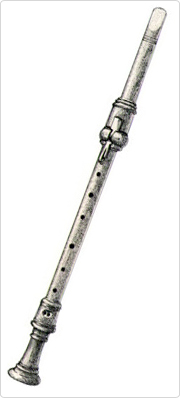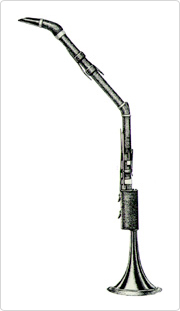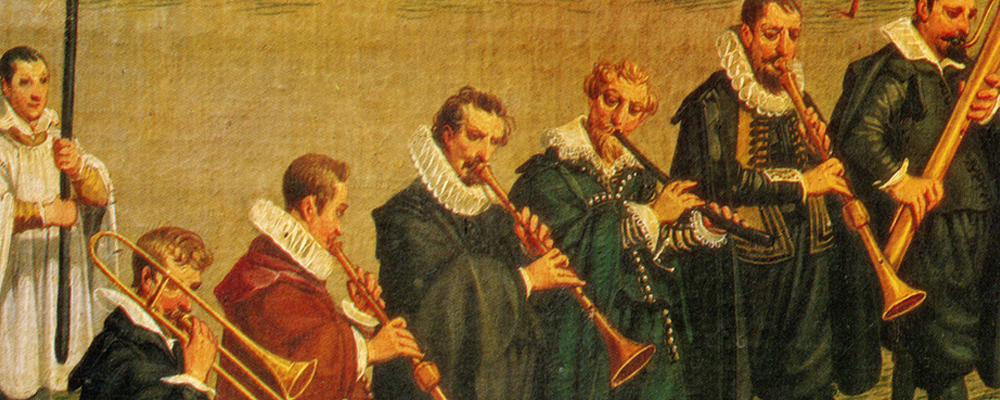The Origins of the Clarinet
The birth of the clarinet
A new woodwind instrument in the eighteenth century
The clarinet is a relative newcomer among woodwind instruments. It is generally said to have been invented by the Nuremberg instrument maker Johann Christoph Denner at the start of the eighteenth century. A similar instrument-the chalumeau-was already in existence. However, although the chalumeau sounded fine at lower registers, the clarinet boasted rich sound quality at both low and high registers. The fact that the name "clarinet" originally meant "small trumpet" ("clarino" means trumpet) was probably also related to this characteristic of the clarinet.

Two-key clarinet made by Denner
The clarinet-an historical instrument with a family that has grown over time
The clarinet family is comprised of a number of similar instruments. It includes instruments of various sizes, such as the piccolo clarinet (or octave clarinet), alto clarinet, bass clarinet, and contrabass clarinet, as well as instruments whose construction is slightly different, such as the basset horn. The basset horn, with its curved tube, was invented in the latter half of the eighteenth century, and was chiefly used in works by classical composers.
There are also instruments of the same size which have tubes of different length. For example, there are various types of soprano clarinet in use, with tube lengths ranging from the C-tube (the shortest tube) to the G-tube (the longest). However, the B♭-tube (B♭ major) soprano clarinet and A-tube (A major) soprano clarinet seem to be the most popular at present.
The clarinet produces sound by means of a single-reed attached to the mouthpiece. The keys are attached to the cylindrical section known as the bore and are used to vary the pitch. Up until the first half of the eighteenth century, the clarinet only had two keys. However, more keys were then gradually added to the instrument to enable the clarinetist to play chromatic scales and clean notes more easily.

Basset horn
The configuration that has now become standard was perfected by Klosé in the mid-nineteenth century, based on the ideas of Theobald Boehm.
Since the instrument is based on Boehm's system, it is called the "Boehm clarinet."
History of the bass clarinet
The first record of a bass clarinet comes from France toward the end of the eighteenth century. We know that it was a man named Gilles Lot who first created an instrument called the Basse-Tube. As the model for the clarinet was created at the beginning of the eighteenth century, the instrument that would become the bass clarinet was only created nearly 100 years later. However, it did not enjoy much success as an instrument at first.
It was not until the next century that the bass clarinet as we know it today, with its large keys and straight tubular body, was first made by Adolph Sax in 1838. This is when the instrument first took its current shape.
The first piece of music to feature the bass clarinet was Meyerbeer's Les Huguenots, which contains a long solo for the instrument in the fifth act. This instrument subsequently was developed into its present shape alongside the B♭ clarinet, appearing using both the Boehm system and the ?hler system.
What clarinets are made of
There are a variety of different materials that clarinets can be made of, but most classical instruments were made of boxwood. Today, however, not only is the music itself different from the era of classical music, but the requirements of the musicians are also different. The instruments themselves have also changed to have wider dynamic ranges, with rich expressive power to send the notes of even the most difficult passages far and wide.
Grenadilla, which is now the most commonly used material for clarinet making, has a higher relative density than boxwood, making it easier to support with the body while performing, thereby allowing for more air volume. When blowing gently, on the other hand, rather than the sound becoming weak it becomes soft and gentle. We can conclude that grenadilla is the most suitable material for what musicians look for in a clarinet in this day and age.
Musical Instrument Guide:Clarinet Contents
Structure
How the Instrument is Made
Choosing an Instrument
Trivia
- "I Broke My Clarinet" is a French folk song
- Inspiring composers
- In Italy, a single B♭ clarinet
- At one time, most clarinets were made of boxwood
- In vogue in the 1900s-the metal clarinet
- A transparent clarinet?
- Famous clarinet works: concertos
- Famous clarinet works: chamber music
- What is the relationship between hertz and cents?

